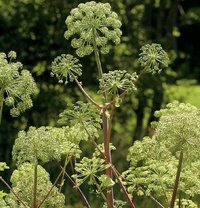Growing Angelica
Growing angelica in your garden can reap big rewards, including more energy and relieving digestive complaints.
Angelica has large, lobed leaves and thick, hollow stems.

Both the leaves and stalks taste sweet and can be used as a natural sweetener.
In the 17th century, angelica was considered one of the most important herbal medicines available.
You can use both roots and leaves of the herb angelica, as well as the seeds. Dry the roots quickly and store them in an airtight container. Use the leaves fresh.
Growing Angelica
For the Medicine Cabinet
The root of herb angelica can be used in an infusion. Drink it daily and within a few days you will have more energy. It's also good to stimulate circulation. If you are suffering from gas, chew the stems of angelica for relief.

In the Kitchen
The stems and seeds can be used for making foods sweet and also for liqueurs. It can also be used to sweeten wine and add a unique, sweet taste to your jams and jellies.
Make a Liqueur
Take one ounce of the fresh leaves, chop them and allow them to steep
along with skinned, chopped almonds in brandy for five days.
At the end of the five days, strain the liquid through muslin and add a
pint of syrup.
The liqueur is good for digestive ailments.
In addition to making a tasty liqueur, the herb angelica is also used to make Vermouth and Chartreuse.
Growing Angelica
The herb angelica prefers a moist, shady spot, although it can also handle some drought and some frost.
If you can get the plants from a greenhouse, it will be easier to grow, but you can also start it from seed.
Work and loosen the soil with compost and organic matter before planting your angelica seeds.
If your angelica is happy, it will reseed itself for up to four years,
but angelica is usually considered a biennial, meaning it's neither an
annual nor a perennial, but something in between.
According to A
Modern Herbal (Volume 1, A-H): The Medicinal, Culinary, Cosmetic and
Economic Properties, Cultivation and Folk-Lore of Herbs, Grasses, Fungi,
Shrubs & Trees with Their Modern Scientific Uses,
the herb angelica might have gotten its name because it tends to bloom
on the day of Michael the Archangel (May 8, old style).
It was once considered a preservative against evil spirits and witchcraft. All parts of the plant were believed efficacious against spells and enchantment. It was held in such esteem that it was called "The Root of the Holy Ghost." (Page 36).
Learn More About Medicinal Herbs










New! Comments
Have your say about what you just read! Leave me a comment in the box below.